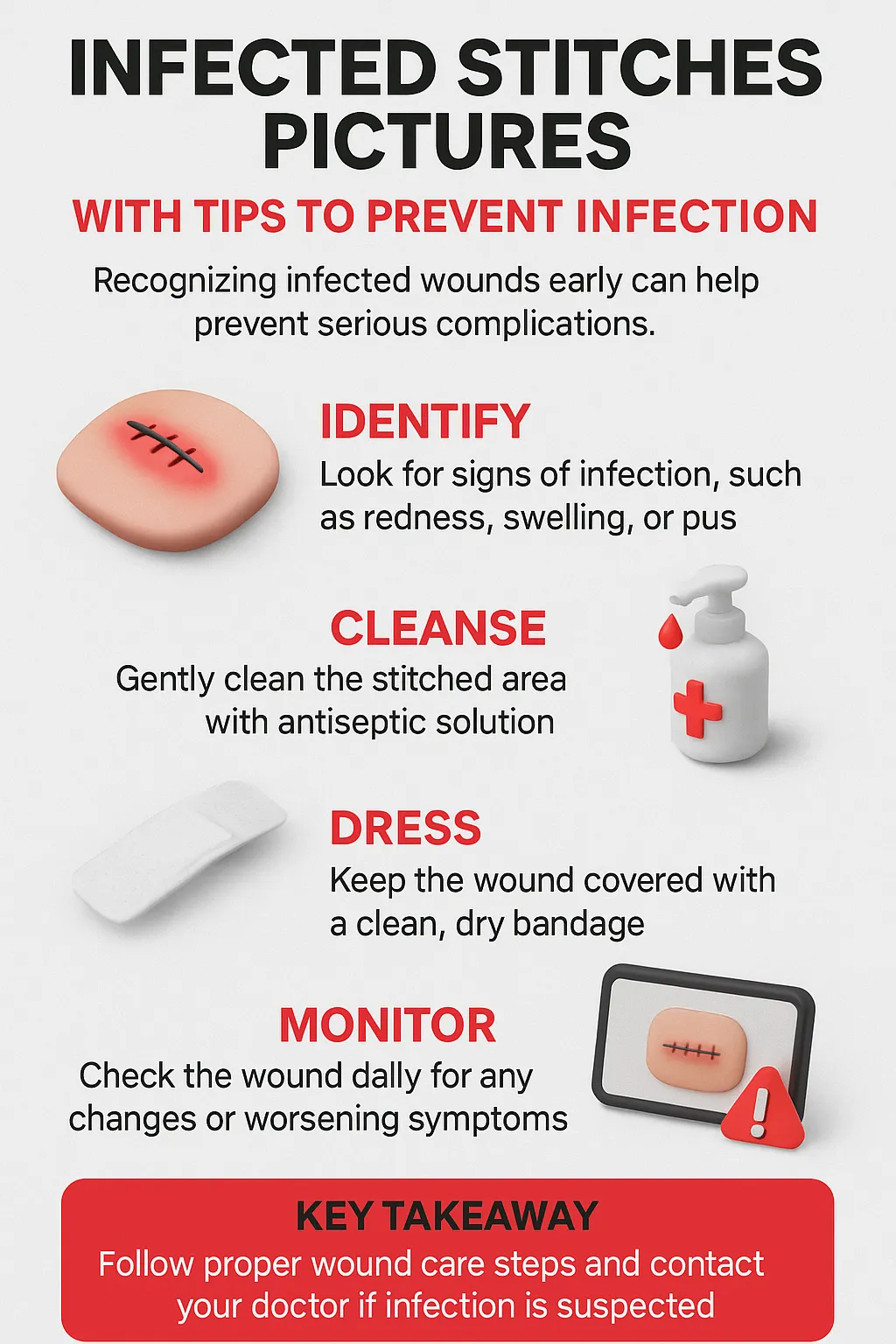If you’ve ever wondered whether your stitches are healing properly, you’re not alone. From my direct experience with post-surgical patients, I’ve seen how easily people confuse normal healing with the earliest signs of infection. That’s why this page offers more than surface-level advice—you’ll find infected stitches pictures you can compare to your own wound, combined with clear prevention tips and expert insights to help you heal safely and confidently.
Top Takeaways
- Use visuals: Reliable infection images help you compare and spot trouble early.
- Recognize warning signs: Redness, swelling, pus, odor, fever, or pain.
- Know the risk: About 500,000 SSIs occur each year in the U.S.
- Take quick action: Call your provider at the first red flag.
- Prevention first: Pictures are for awareness; proper care prevents infection.
What Infected Stitches Pictures Reveal and How to Prevent Infection
Infected stitches pictures make it easier to see the difference between normal healing and infection. Healthy stitches may be mildly red, a little tender, and improve over time. Infected stitches, however, often worsen—showing spreading redness, swelling, heat, or pus.
Looking at infection stages—from mild to severe—helps you recognize when it’s time to seek care. At the same time, simple prevention measures like keeping your wound clean, changing dressings properly, and washing your hands before touching stitches drastically reduce the risk of infection.
If your wound resembles advanced infection images or you have fever and severe pain, it’s essential to seek medical attention right away.
Expert Insight
“In my experience, the earliest changes—like redness creeping beyond the stitches or drainage becoming thicker—are the ones patients often miss. Using reference pictures alongside consistent wound care can prevent a small issue from becoming a dangerous complication.”
Case Studies & Real-World Lessons
Catching Infection Early – Maria’s Story
- 42-year-old recovering from abdominal surgery.
- By day 3: redness and swelling appeared.
- Called her doctor immediately and started antibiotics.
- Outcome: Infection stopped early, recovery improved.
Delaying Care – James’s Story
- 29-year-old recovering from knee surgery.
- Thought worsening pain was “normal healing.”
- Within a week: thick yellow discharge and odor appeared.
- Needed in-office wound cleaning and strong antibiotics.
- Later admitted: “If I had looked at reference pictures sooner, I’d have acted earlier.”
Key Insight: Small differences—like clear vs. cloudy discharge—can signal big risks. Patients who use visual references are more likely to act early and avoid serious complications.
Supporting Statistics and Prevention Insights
- 500,000 surgical site infections (SSIs) occur in the U.S. every year.
Prevention Tip: Meticulous hygiene, proper dressing changes, moist wound treatment, and quick reporting of changes are the strongest defenses.
Final Thought & Opinion
Looking at infected stitches pictures isn’t about fear—it’s about prevention. Patients who recognize subtle warning signs and follow proper wound care guidelines recover more quickly and with fewer complications.
My opinion: Reliable images combined with prevention strategies are one of the most powerful tools a patient can use. They don’t replace a doctor’s judgment, but they give patients confidence, awareness, and control during recovery. With the added support of virtual telehealth wound-care services, patients can gain timely guidance while using these images and strategies to better manage their healing process.
Next Steps
- Compare: Use trusted infection pictures as a visual guide.
- Check: Look for red flags—redness, swelling, pus, odor, fever, pain.
- Document: Take daily photos of stitches.
- Contact: Call your provider if symptoms worsen.
- Prevent: Wash hands, follow wound-care instructions, change dressings.
Remember: Early action and consistent prevention can protect your healing process.
Frequently Asked Questions (FAQs)
What do infected stitches pictures show?
They highlight common signs of infection such as spreading redness, swelling, pus, foul odor, or worsening pain—helping you recognize red flags early.
How can I use pictures to prevent infection?
By comparing your healing wound to reference images, you can spot unusual changes sooner. This prompts faster action and reduces the risk of severe complications.
What are the most important tips to prevent infection in stitches?
Keep the wound clean, wash your hands before touching stitches, change dressings as instructed, and avoid scratching or applying unapproved creams.
When should I call my doctor after checking infected stitches pictures?
If you see worsening redness, thick drainage, odor, fever, or severe pain, contact your healthcare provider immediately for evaluation.
Are infected stitches pictures a substitute for medical advice?
No. They’re a helpful awareness tool but should never replace professional care. Use them as a guide, but always follow your doctor’s instructions.
When learning from Infected Stitches Pictures With Tips to Prevent Infection, it’s clear that prevention and maintenance are just as important in health as they are in home care. Just like keeping wounds clean lowers infection risks, services such as dryer vent cleaning in Fort Green Springs or scheduling a HVAC tune-up in Miami Beach, FL help prevent bigger problems before they start. Using high-quality filters, whether it’s the 4x20x2 Pleated Furnace Filters on Amazon or the 16x25x4 MERV 13 Pleated HVAC AC Furnace Air Filters (4-Pack) from Walmart, ensures clean air circulation—much like keeping stitches clean ensures better healing. Even practical solutions like the ones you can find on eBay contribute to creating healthier spaces, reminding us that both medical recovery and home systems thrive when prevention and care go hand in hand.







